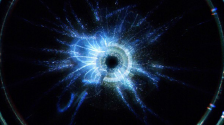Audi-visual art: Edge of the Observable 2014
[With physicist Wolfgang Adam HEPHY/ AUT]
Is an audio-visual artwork which explores the limits of materiality and knowledge, through an experimental re-manifestation of data from experiments at the Large Hadron Collider (LHC). The experiments undertaken at the LHC probe the nature of the universe through the focusing of trillions of electron volts on unimaginably small particles that are accelerated to almost the speed of light around the twenty seven kilometre ring. When they collide with each other, they release immense energies for an instant of time which are captured by gargantuan detectors. Such spatial, temporal and energetic extremes contain an essence of the sublime, a term that can be described as the sensation of apprehending that which is beyond humanity’s grasp or limits of understanding. The philosopher Immanuel Kant posits two types of sublime: the “mathematical” which deals with scale, and the “dynamic” which deals with the might and power of nature. According to Kant, we find ourselves at the limits of our ability to intuitively grasp or aesthetically measure such factors, due to the ‘limitations of the finite, human faculties of sensibility’. Both forms of the sublime are encapsulated by the complexity of the LHC and the tremendous energy it creates, however this is a kind of inversion of the Kantian sublime of scale and dynamics, it is the sublime of the near-infinitely small yet near-infinitely energetic. And the LHC manifests another limit, the limit of knowledge itself, as the experiments undertaken are literally testing the boundaries of scientific knowledge and our understanding of the universe.
